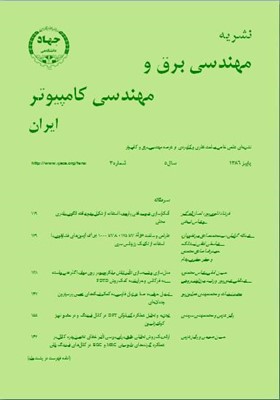ارائه يك روش تحليلي دقيق براي بررسي تأثير خطای تخمين بهره کانال بر عملكرد گيرندههای دايورسيتي MRC و EGC در کانالهاي فيدينگ رايلي
محورهای موضوعی : electrical and computer engineering
1 - مرکز تحقیقات مخابرات ایران
2 - دانشگاه تربيت مدرس
کلید واژه: دايورسيتيفيدينگ رايليخطاي گوسيMRCEGC,
چکیده مقاله :
براي انتخاب و وزندهي سيگنالهاي دريافتي در شاخههاي دايورسيتی و ترکيب همدوس آنها، نياز به تخمين بهره کانال ميباشد. فرآيند تخمين کانال ايدهآل نبوده و خطاهاي ناشي از آن باعث ايجاد خطا در تعيين ضرايب وزندهي مورد استفاده در شاخههاي دايورسيتي خواهد شد. اين خطاها معمولاً به صورت متغيرهاي گوسي مدل ميشوند. در اين مقاله يک روش تحليلي دقيق براي بررسي عملکرد شماهاي دايورسيتي MRC و EGC در کانالهاي فيدينگ رايلي با در نظر گرفتن خطاهاي گوسي در ضرايب وزندهي ارائه میشود. در مقايسه با روشهاي تحليلي موجود، روش ارائهشده در اين مقاله منجر به يک رابطه بسته براي محاسبه احتمال خطاي متوسط ميگردد. در روش پيشنهادي پارامتر جديدي با عنوان سيگنال به نويز مؤثر مورد استفاده قرار میگيرد که معرف تأثيرات ناشي از خطاهاي گوسي موجود در ضرايب وزندهي ميباشد. روابط ارائهشده نشان ميدهند که ميتوان احتمال خطاي متوسط را با استفاده از روابط دقيق موجود که با فرض ايدهآلبودن فرآيند تخمين کانال استخراج شدهاند و صرفاً با جايگزيننمودن سيگنال به نويز در هر شاخه دايورسيتي با سيگنال به نويز مؤثر، محاسبه کرد. فرم بسته و مناسب روابط تحليلي ارائهشده در اين مقاله اجازه ميدهد تا بتوان از آنها به عنوان ابزار مناسبي براي بررسي عملکرد گيرندههاي MRC و EGC در کانالهاي فيدينگ رايلي و نيز تحليل تأثير خطاهاي ناشي از تخمين کانال استفاده نمود.
In this paper, the probability of error of maximal-ratio combining (MRC) and equal-gain combining (EGC) diversity schemes with coherent binary phase shift keying (BPSK) is analyzed over Rayleigh fading channels in the presence of channel estimation error. The channel estimation errors cause errors in the required weighting coefficients of the diversity receivers. Such errors are generally modeled as complex Gaussian random variables. Based on this assumption, we develop novel exact analytical equations for the calculation of the probability of error in the presence of Gaussian errors in the weighting coefficients. Results show that the exact probability of error can be derived using the existing equations under the assumption of perfect channel estimation and by replacing the SNR with an effective SNR, which is due to the weighting coefficients errors.
[1] P. Bello and B. D. Nelin, "Predetection diversity combining with selectively fading channels," IEEE Trans. Commun. Syst., vol. 10, no. 1, pp. 32-42, Mar. 1962.
[2] J. Gans, "The effect of Gaussian error in maximal ratio combiners," IEEE Trans. Commun. Technol., vol. 19, no. 4, pp. 492-500, Aug. 1971.
[3] B. R. Tomiuk, N. C. Beaulieu, and A. A. Abu-Dayya, "General forms of maximal ratio diversity with weighting errors," IEEE Trans. Commun., vol. 47, no. 4, pp. 488-492, Apr. 1999.
[4] A. Annamalai, "The effect of Gaussian error on the selection diversity combiners," Wiley J. Wireless Commun. Mob. Comput., vol. 1, no. 3, pp. 419-435, Jul. 2001.
[5] A. Annamalai and C. Tellambura, "Analysis of hybrid selection/maximal ratio diversity with Gaussian errors," IEEE Trans. Wireless Commun., vol. 1, no. 3, pp. 498-512, Jul. 2002.
[6] Y. Ma, R. Schober, and S. Pasupathy, "Effect of imperfect channel estimation on MRC diversity in fading channels," in Proc. IEEE ICC’04, vol. 6, pp. 3163-3167, Jun. 2004.
[7] Y. Ma, R. Schober, and S. Pasupathy, "Effect of imperfect channel estimation on MRC diversity in fading channels," IEEE Trans. Veh. Technol., vol. 54, no. 1, pp. 2137-2142, Nov. 2005.
[8] W. Gifford, M. Win, and M. Chiani, "Diversity with practical channel estimation," IEEE Trans. Wireless Commun., vol. 4, no. 4, pp. 1935-1947, Jul. 2005.
[9] L. Cao and N. C. Beaulieu, "Exact error rate analysis of diversity 16-QAM with channel estimation error," IEEE Trans. Commun., vol. 52, no. 6, pp. 1019-1029, Jun. 2004.
[10] S. Verdo, Multiuser Detection. Cambridge, U. K.: Cambridge Univ. Press, 1998.
[11] J. G. Proakis, Digital Communications, 3rd edition. New York: McGraw-Hill, 1995.
[12] A. Annamalai and C. Tellambura, "Equal gain diversity receiver performance in wireless channels," IEEE Trans. Commun., vol. 48, no. 10, pp. 1732-1745, Oct. 2000.

